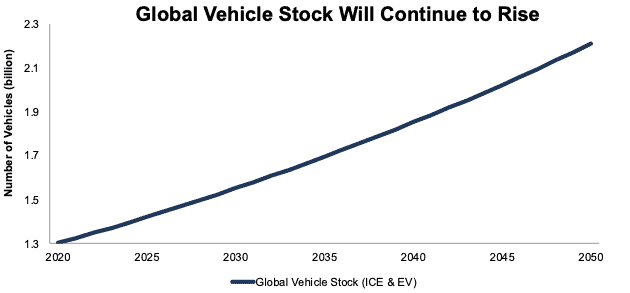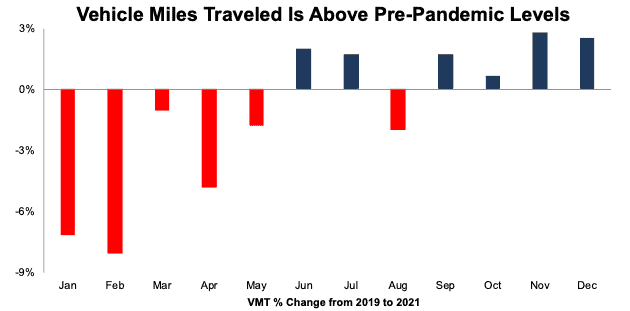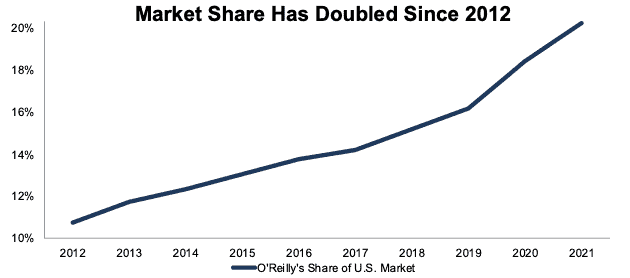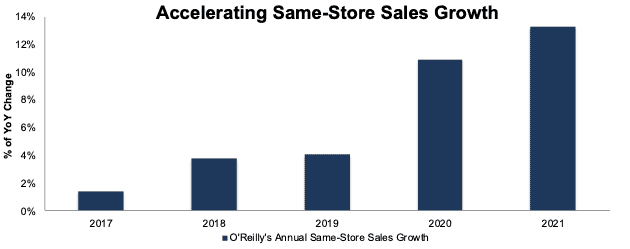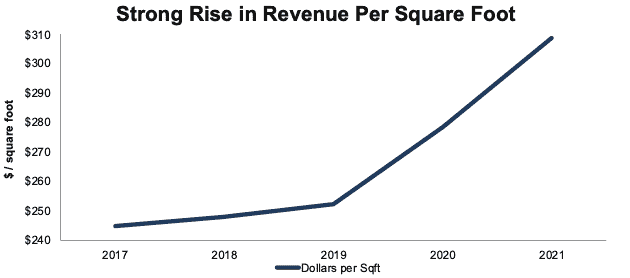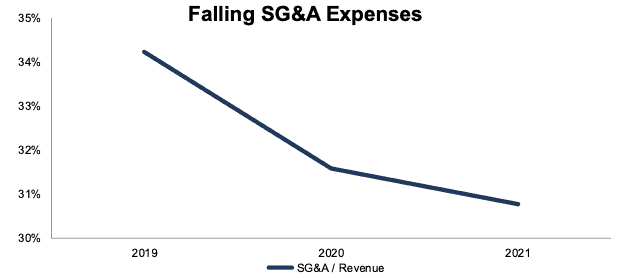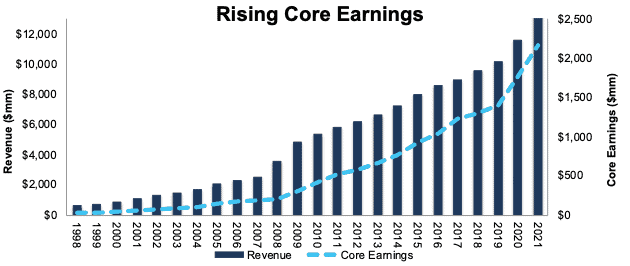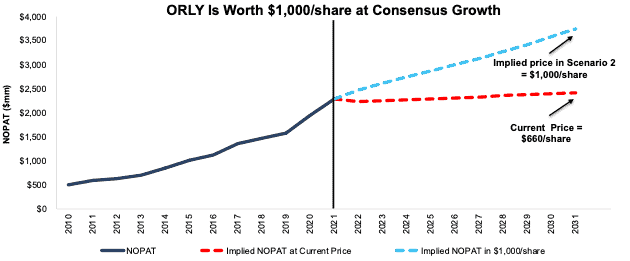We published an update on ORLY on February 15, 2023. A copy of the associated Earnings Update report is here.
A growing physical store network equips this company to offer more consumers an extensive product selection alongside knowledgeable service. Though this company improved profitability in each of the past 12 years, its stock is priced as if profits will never exceed current levels. Favorable long-term industry trends, excellent management incentive structures, and a business with a widening competitive advantage make O’Reilly Automotive (ORLY: $660/share) this week’s Long Idea.
O’Reilly’s stock presents quality risk/reward given the company’s:
- position to benefit from growth in the global vehicle stock and miles traveled
- growing physical store network that exposes the brand to more new customers
- consistent and accelerating market share growth
- accelerated growth strategy for professional customers
- increasing operational efficiencies in its physical stores
- valuation implies the company will not grow profits from current levels
Demand for Auto Parts Will Grow With Global Vehicle Stock
The U.S. Energy Information Administration’s (EIA) reference case projects the global internal combustion engine (ICE) light-duty vehicle fleet will peak in 2038. However, the growth in electric vehicles (EVs) will continue to expand the overall global vehicle fleet as the EIA forecasts EVs to account for 31% of the global fleet in 2050, up from less than 1% in 2020. In total, the EIA expects the global vehicle stock to rise from 1.3 billion in 2020 to 2.2 billion in 2050, growing 2% compounded annually, per Figure 1.
Figure 1: Global Vehicle Stock (ICE & EV) Reference Case: 2020 – 2050
Sources: New Constructs, LLC and EIA
Maintenance Costs Will Rise During EV Adoption
EVs require less maintenance than ICE vehicles, which may cause some to wonder what the long-term growth prospects are for the aftermarket auto parts industry. However, the rising adoption of EVs does not mean there will be less overall demand for automotive maintenance or auto parts. On the contrary, the increase in the number of vehicles in the global fleet will continue to drive total maintenance demand higher through 2050, even as the adoption of EVs lowers per-vehicle maintenance requirements.
AAA’s Your Driving Cost study discovered maintenance, repair, and tire costs for EVs total $949/year, which is $330/year below ICE vehicles in 2019 (latest available year). If we apply these costs to the entire global fleet in 2020, maintenance costs for ICE vehicles were $1,664 billion compared to just $1 billion for EVs. Assuming per-vehicle ICE and EV maintenance costs stay the same, total global maintenance costs will grow by 2% compounded annually, from $1,665 billion in 2020 to $2,605 billion in 2050.
Figure 2: Implied Maintenance Spending[1]: 2020 Vs. 2050
Sources: New Constructs, LLC, EIA, and AAA
Miles Traveled Are Above Pre-Pandemic Levels
Vehicle miles traveled (VMT) is another indicator of future demand for the auto parts industry. VMTs consistently rose in the U.S. from 107 billion in 1970 to 293.3 billion in 2019, 2% growth compounded annually. COVID-related lockdowns caused a decline in VMT throughout 2020 and 1H21, but VMT has since recovered to above pre-pandemic levels.
Figure 3 shows the two-year change in VMT by month. In six of the last seven months of 2021 (latest available data), VMT was higher than the comparable 2019 month. The recovery of driving demand beyond 2019 levels means suppliers, such as O’Reilly, can anticipate even more demand for their products as more parts wear out from additional use.
Figure 3: Two-Year Percent Change in Vehicle Miles Traveled by Month: 2019 – 2021
Sources: New Constructs, LLC and FRED
EVs and Self-Driving Will Drive VMT Higher
According to AAA, 43% of EV owners say they drive more miles after owning an EV than before. Increased VMT for EVS will likely offset the EV per-vehicle maintenance cost savings that EVs promise.
The same is true for self-driving cars...over the long term. Self-driving technology creates a significant reduction in perceived travel-time costs, which could result in people driving drive more frequently and for longer periods of time.
O’Reilly’s Extensive Store & Distribution Network Widens the Moat…
To effectively compete in the auto parts retail industry, today and in the future, O’Reilly leverages its extensive store and distribution center network to offer customers convenience, a wide selection of inventory, and expert customer service.
O’Reilly operates 5,784 stores totaling 43.2 million square feet with approximately 21,000 stock keeping units (SKUs). However, stores have same-day access to two to four times more inventory from the larger hub and super hub stores that carry 45,000 – 92,000 SKUs. Twenty-eight distribution centers further support stores with same-day or overnight access to an average of 158,000 SKUs. For reference, AutoZone (AZO) operates 6,785 stores with 45.1 million square feet. AutoZone’s hub and mega hub stores carry between 40,000 – 110,000 SKUs.
As O’Reilly continues to add more locations and improve its efficiencies, its physical network increasingly becomes more and more difficult to replicate. Nationwide box stores lack the geographic reach into smaller markets that O’Reilly’s smaller stores penetrate while online competitors lack the convenience of a nearby physical location staffed with experienced employees.
Further, big-box retailers such as Walmart (WMT) and online retailers such as Amazon (AMZN) cannot match O’Reilly’s key advantage as a specialist: broad parts selection supported by expert customer service.
…and Grows Market Share
O’Reilly aims to win customers through service and inventory availability. When the company enters new markets, it first establishes larger stores in more densely populated areas and then adds clusters of secondary stores into more thinly populated areas with less competition. Larger stores supply same-day inventory to smaller stores in a thoughtful expansion strategy reminiscent of Walmart. O’Reilly’s efficient distribution system, improving fill rates at its distribution centers, and strong supplier relationships enable it to keep more inventory in stock than smaller competitors.
This winning model helped double O’Reilly’s share of U.S. auto parts stores from 10% in 2012 to 20% in 2021. See Figure 4. In 2022, O’Reilly is aggressively pursuing additional market share gains by lowering prices to its professional customers and opening 175 – 185 new stores during the year.
Figure 4: O’Reilly’s Share of U.S. Auto Parts Stores: 2012 – 2021
Sources: New Constructs, LLC, company filings, and IBISWorld
Same-Store Sales Growth Is Accelerating
O’Reilly’s annual same-store sales growth has accelerated each year since 2017. While company guidance for same-store sales growth of 5-7% in 2022 is lower than the previous two years, it is still above its pre-pandemic levels.
Figure 5: Same-Store Sales: 2017 – 2021
Sources: New Constructs, LLC and company filings
This guidance is likely on the conservative side as the company has a good track record of under-promising and over-delivering on earnings. According to Zacks, O’Reilly has beaten earnings estimates in nine of the past 10 quarters. Over the past four quarters, the company beat earnings by an average of 22%.
Getting More Efficient With Its Footprint
While growing its store count from 5,019 in 2017 to 5,784 in 2021, O’Reilly is also generating more revenue from its stores. Per Figure 6, the company’s revenue per store square foot improved from $244 in 2017 to $309 in 2021.
Figure 6: Revenue per Total Domestic Store Square feet: 2017 – 2021
Sources: New Constructs, LLC and company filings
Expenses Are Falling While Revenues Rise
While expanding the top-line, O’Reilly also reduced expenses. The company’s selling, general, and administrative expenses as a percent of revenue fell from 34% in 2017 to less than 31% in 2021.
Figure 7: O’Reilly’s Selling, General & Administrative Expenses: 2019 – 2021
Sources: New Constructs, LLC and company filings
Industry-Leading Profitability
With revenue per square foot on the rise and expenses on the decline, it’s no surprise that O’Reilly’s return on invested capital (ROIC) improved year-over-year (YoY) in each of the past 12 years. The company generates industry-leading net operating profit (NOPAT) margins, invested capital turns, and ROIC. See Figure 8. O’Reilly’s NOPAT margin rose from 9% in 2010 to 18% in 2021, while invested capital turns rose from 1.1 to 2.1. Rising margins and invested capital turns drove the company’s ROIC from 10% in 2010 to 38% in 2021.
Figure 8: O’Reilly’s Profitability Vs. Peers: 2021
Sources: New Constructs, LLC and company filings
Room for More Than One Winner in the Auto Parts Market
As our clients know, AutoZone (AZO) is one of our very successful Long Ideas, original report published in November 2018. We remain bullish on AZO as detailed in our January 12, 2022 report here. We think the U.S. auto parts stores market has plenty of room for two winners, and, so we’re bullish on both AZO and ORLY. Both companies have an extensive distribution and customer service network that enables them to operate highly profitable businesses that will win business away from smaller local and regional suppliers.
O’Reilly’s management noted in the 4Q21 earnings call that market share gains were primarily from “the weaker, independent competitors that have struggled the last couple of years with supply…” As the industry continues to consolidate, we expect AutoZone and O’Reilly to continue to take market share away from less advantaged competitors. Combined, the two companies’ share of the U.S. auto parts market was ~40% in 2021[2].
Steady Core Earnings Growth
O’Reilly’s expanding competitive advantages also drive consistent profit growth. The company’s Core Earnings have risen YoY in each of the past 23 years. Per Figure 9, O’Reilly’s Core Earnings grew from $27 million in 1998 (the earliest year in our model) to $2.2 billion in 2021, or 21% compounded annually.
Figure 9: O’Reilly’s Revenue & Core Earnings Since 1998
Sources: New Constructs, LLC and company filings
Fears of Slowing Store Growth Are Overblown
The larger O’Reilly’s physical store network grows, the more difficult it becomes to match historical growth rates. With stores in 47 states, O’Reilly’s large network may lead some to wonder how much room is left for the company to expand its store count domestically.
The company’s store count does shows signs of slowing as its 10-year CAGR of 4.5% is higher than its 3-year CAGR of just 3.5%. In 2021, the company grew its store count by an even slower 3.0%.
However, a slowing store count CAGR does not mean O’Reilly has run out of opportunities to expand its physical network. On the contrary, O’Reilly’s improved competitive position in its markets will likely lead to the exit of more smaller, less efficient businesses, which creates more opportunities for O’Reilly to increase its store count within many of the markets it already competes.
Additionally, O’Reilly noted in its 4Q21 earnings call that it still has a “gap” in its national footprint. In the eight Northeastern states it currently serves, O’Reilly operates around one store for every 189,000 people. For reference, across its entire network, O’Reilly operates one store for every 56,000 people in the United States. This gap in the Northeast hinders the company’s ability to win larger national accounts. Expanding its store network in areas, such as the Northeast, presents the company with more national growth opportunities.
Beyond new stores, O’Reilly has generated 29 consecutive years of same-store-sale growth. Even if new store growth slows, the company has proven its ability to grow sales through existing locations.
Continued Growth Even Without Pandemic Boost
O’Reilly’s revenue grew at a 15% CAGR over the past two years as government stimulus provided consumers with extra funds for repairs and maintenance they otherwise might have put off. Additionally, with the large number of people working from home, do-it-yourself (DIY) projects became more popular. However, as 2022 continues to trend away from pandemic-related restrictions, and with no plans for more pandemic-related stimulus, the growth in DIY projects could slow.
Nonetheless, the company’s midpoint revenue guidance for 2022 is still a strong 8% above 2021 levels.
Profitability Can Improve Despite Compressed Margins
Rising costs and a more competitive pricing strategy may lead some to believe the company will be less profitable going forward. However, the company saw meaningful revenue growth in the markets in which it tested its low price strategy. O’Reilly expects its company-wide rollout of the pricing strategy will likewise drive enough revenue growth in its professional segment to offset lower margins.
In other words, we expect added revenue from the professional segment will improve the company’s invested capital turns (revenue / invested capital) more than rising costs will depress NOPAT margins. As a result, we think the company’s return on invested capital (ROIC) will continue to rise.
The company’s recent ability to improve its invested capital turns gives us confidence it will continue to do so as it executes its pricing strategy. Since 2017, the company’s invested capital turns improved from 1.6 to 2.1.
ORLY Has 52% Upside If Consensus Is Correct
O’Reilly’s price-to-economic book value (PEBV) ratio of 1.0 means the stock is priced for profits to never meaningfully grow from 2021 levels. Below we use our reverse discounted cash flow (DCF) model to quantify the expectations baked into the current stock price and highlight the upside in ORLY should profits grow as analysts expect.
DCF Scenario 1: to Justify the Current Stock Price of $660/share.
If we assume O’Reilly’s:
- NOPAT margin falls to 17% (three-year average vs. 18% in 2021) in 2022 through 2031 and
- revenue grows at just a 1% CAGR (vs. 2022 – 2024 consensus estimate CAGR of 6%) from 2022 – 2031, then
the stock is worth $660/share today – equal to the current stock price. In this scenario, O’Reilly earns $2.4 billion in NOPAT in 2031, which is just 5% above 2021 NOPAT.
DCF Scenario 2: Shares Are Worth $1,000+.
If we assume O’Reilly’s:
- NOPAT margin falls to 17% from 2022 through 2031, and
- revenue grows at consensus estimates of 8% in 2022, 6% in 2023, and 5% in 2024, and
- revenue grows at a 4.5% CAGR from 2025 – 2031 (nearly half its 10-year revenue CAGR of 9% from 2011 – 2021), then
the stock is worth $1,002/share today – a 52% upside to the current price. In this scenario, O’Reilly’s NOPAT grows just 5% compounded annually for the next decade, or one-third of the company’s 15% NOPAT CAGR from 2011 – 2021. Should O’Reilly’s NOPAT grow in line with historical growth rates, then the stock has even more upside.
Figure 10 compares O’Reilly’s historical NOPAT to its implied NOPAT in each of the above DCF scenarios.
Figure 10: O’Reilly’s Historical and Implied NOPAT: DCF Valuation Scenarios
Sources: New Constructs, LLC and company filings
Sustainable Competitive Advantages Will Drive Shareholder Value Creation
Here’s a summary of why we think the moat around O’Reilly’s business will enable it to continue to generate higher NOPAT than the current valuation implies.
- scale advantages from large nation-wide store and distribution network
- improving same-store economics
- strong customer service
- industry-leading ROIC
What Noise Traders Miss With O’Reilly
These days, fewer investors focus on finding quality capital allocators with shareholder friendly corporate governance. Instead, due to the proliferation of noise traders, the focus is on short-term technical trading trends while more reliable fundamental research is overlooked. Here’s a quick summary of what noise traders are missing:
- long-term demand for automobiles and the parts needed to maintain them
- industry-wide supply chain problems and aggressive pricing strategy create opportunities for O’Reilly to take more market share
- ROIC has improved year-over-year in each of the past 12 years
- valuation implies 52% upside even if NOPAT grows at just half the rate of the prior decade
Should O’Reilly’s new competitive pricing strategy for its professional service segment prove more successful than anticipated, investors could reward market share gains and accelerated profit growth by bidding the share price up.
Share Repurchases Could Provide 3.6% Yield
O’Reilly does not pay dividends and has no plans to pay any in the future.
Instead of dividends, O’Reilly returns capital to shareholders through share repurchases. From 2017 to 2021, the company repurchased $9.9 billion (22% of current market cap) worth of stock. The company has ~$1.6 billion of remaining repurchase authorization. If the company uses its remaining repurchase authorization in 2022, the buybacks will provide a 3.6% yield at the current market cap.
Executive Compensation Plans Align Executives’ Interests With Shareholders’
No matter the macro environment, investors should look for companies with executive compensation plans that directly align executives’ interests with shareholders’ interests. Quality corporate governance holds executives accountable to shareholders by incentivizing them to allocate capital prudently.
O’Reilly compensates executives with salaries, annual bonuses, and long-term equity awards. Most importantly, twenty percent of O’Reilly’s annual cash bonuses are tied to target return on invested capital (ROIC) levels.
Tying executive compensation to ROIC, which evaluates the company’s true returns on the total amount of capital invested in the company, ensures that executives’ interests are aligned with shareholders’ interests as there is a strong correlation between improving ROIC and increasing shareholder value.
O’Reilly’s focus on ROIC has helped it grow economic earnings from $414 million in 2012 to $2.1 billion in 2021.
Insider Trading and Short Interest Trends
Over the past three months, insiders have bought one thousand shares and sold nine thousand shares for a net effect of ~eight thousand shares sold. These purchases represent less than 1% of shares outstanding.
There are currently 871 thousand shares sold short, which equates to 1% of shares outstanding and just under two days to cover. Short interest decreased 30% from the prior month. The lack of short interest reveals not many are willing to wager on shares falling from here.
Critical Details Found in Financial Filings by Our Robo-Analyst Technology
Fact: we provide more reliable fundamental data and earnings models – unrivaled in the world.
Proof: Core Earnings: New Data & Evidence, forthcoming in The Journal of Financial Economics.
Below are specifics on the adjustments we make based on Robo-Analyst findings in O’Reilly’s 10-K:
Income Statement: we made $315 million of adjustments, with a net effect of removing $179 million in non-operating expenses (1% of revenue). Clients can see all adjustments made to O’Reilly’s income statement on the GAAP Reconciliation tab on the Ratings page on our website.
Balance Sheet: we made $356 million of adjustments to calculate invested capital with a net decrease of $13 million. One of the largest adjustments was $36 million in operating leases. This adjustment represented 1% of reported net assets. Clients can see all adjustments made to O’Reilly’s balance sheet on the GAAP Reconciliation tab on the Ratings page on our website.
Valuation: we made $6.9 billion of adjustments to shareholder value for a net effect of decreasing shareholder value by $6.7 billion. Apart from total debt, one of the most notable adjustments to shareholder value was $373 million in outstanding employee stock options (ESO). This adjustment represents <1% of O’Reilly’s market cap. Clients can see all adjustments to O’Reilly’s valuation on the GAAP Reconciliation tab on the Ratings page on our website.
Attractive Funds That Hold ORLY
The following funds receive our Very Attractive rating and allocate significantly to ORLY:
- Pacer U.S. Cash Cows Growth (BUL) – 5.3% allocation
- Acquirers Fund (ZIG) – 3.4% allocation
- VictoryShares U.S. Multi-Factor Minimum Volatility ETF (VSMV) – 3.1% allocation
- Invesco Dynamic Market ETF (PWC) – 2.8% allocation
- Hennessy Cornerstone Large Growth Fund (HILGX, HFLGX) – 2.5% allocation
This article originally published on March 9, 2022.
Disclosure: David Trainer, Kyle Guske II, and Matt Shuler receive no compensation to write about any specific stock, style, or theme.
Follow us on Twitter, Facebook, LinkedIn, and StockTwits for real-time alerts on all our research.
[1] Implied maintenance costs calculated from EIA global light vehicle stock reference case and AAA average annual maintenance, repair, and tire costs.
[2] AutoZone discloses the number of domestic stores, which equals 89% of total stores, but not domestic revenue. We estimate AutoZone’s 2021 domestic revenue as 89% of its total revenue, or $13.5 billion.

